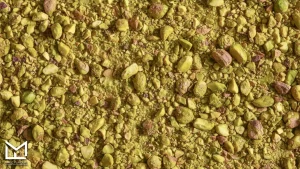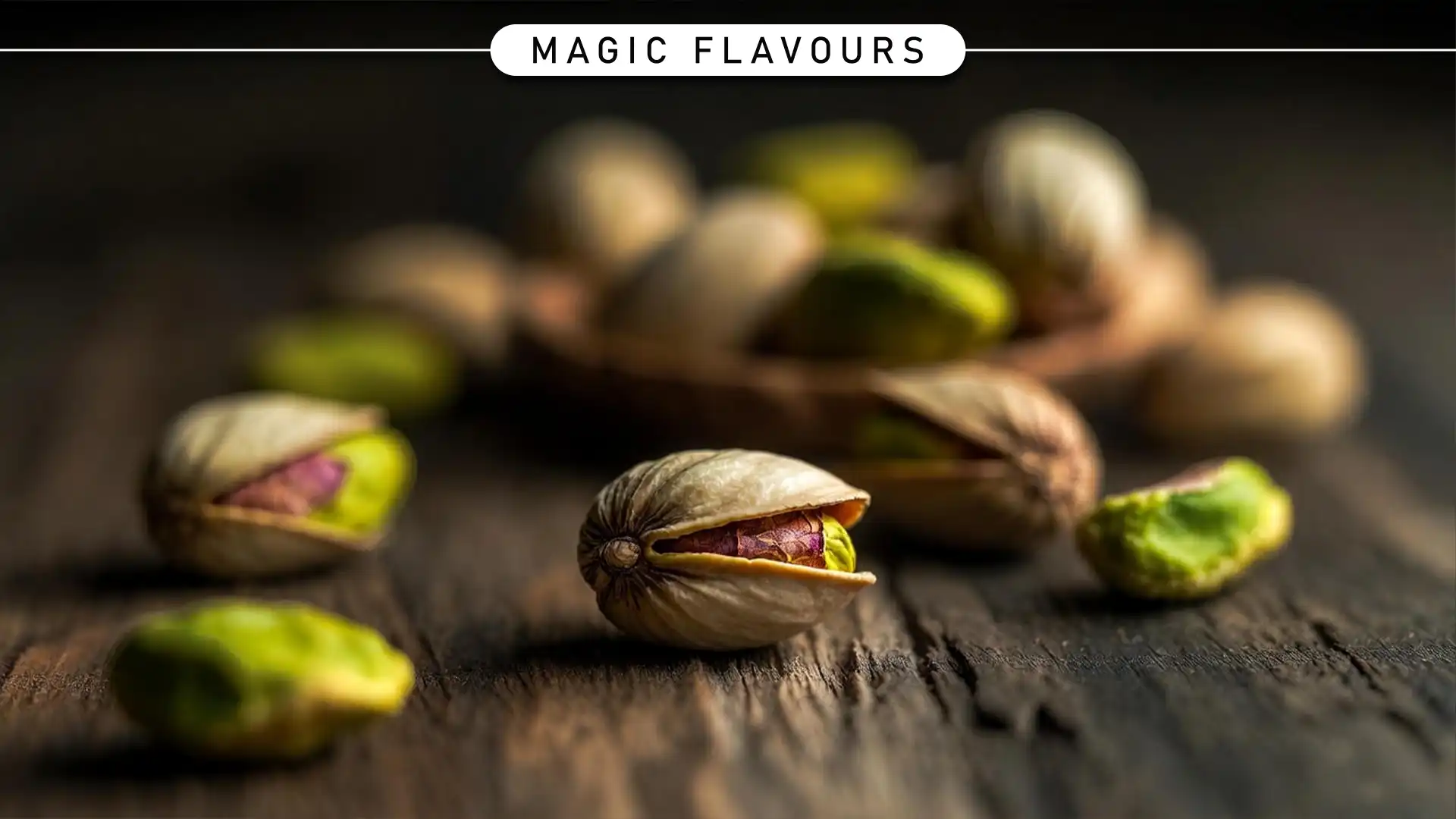1. Introduction to Pistachio Flavor

Pistachio flavor is a rich, nutty, and slightly sweet taste derived from the seeds of Pistacia vera. In addition, it is prized worldwide for its versatility in culinary and commercial applications. Furthermore, its luxurious profile elevates desserts, beverages, and even savory dishes, making it a favorite among chefs and flavor developers.
Moreover, pistachio flavor has strong B2B value. Companies can use it to create unique product lines or enhance premium offerings. In addition, its distinctive taste helps brands stand out in crowded markets. Therefore, applying pistachio flavor strategically can boost consumer satisfaction and brand positioning.
In addition, it blends sensory pleasure with cultural appeal. Widely used in Mediterranean, Middle Eastern, and Western desserts, it bridges tradition and innovation. Consequently, its aroma and taste evoke both nostalgia and modern sophistication, making it a versatile ingredient for many applications.
2. Origins and Source of Pistachio Flavor
Botanical Name: Pistacia vera
Pistachio flavor comes from the seeds of Pistacia vera, a deciduous tree native to arid regions. In addition, these seeds develop a natural, nutty aroma as they mature. Furthermore, the tree produces high-quality nuts that are ideal for both raw consumption and flavor extraction. As a result, the botanical origin directly influences the richness and authenticity of pistachio flavor.
Geographic Origins (Middle East, Iran, USA, Mediterranean)
Moreover, pistachios are primarily cultivated in Iran, the Middle East, the United States, and Mediterranean countries. For example, Iranian pistachios are prized for their vibrant green color and deep nutty taste. In addition, American and Mediterranean pistachios offer unique variations in flavor intensity and sweetness. Therefore, sourcing from these regions ensures high-quality flavor with consistent aroma and taste.
Traditional Harvesting and Processing Methods

In addition, traditional harvesting involves hand-picking or mechanical shaking to collect mature nuts. Furthermore, careful drying and roasting enhance the natural pistachio flavor without overpowering its subtle sweetness. As a result, these methods preserve both aroma and taste, ensuring premium quality for culinary and B2B applications.
3. Flavor Profile and Characteristics of Pistachio Flavor
Nutty, Creamy, Slightly Sweet Notes
Pistachio flavor is naturally nutty, creamy, and subtly sweet, making it versatile across many culinary applications. In addition, its rich aroma enhances desserts, beverages, and even savory dishes. Furthermore, the unique combination of taste and fragrance creates a luxurious and indulgent sensory experience. As a result, flavor is highly valued by chefs, flavor developers, and consumers seeking premium products.
Moreover, this flavor carries a distinct green and earthy undertone that adds depth to recipes. In addition, this complexity allows it to balance sweetness or richness in both traditional and modern dishes. Therefore, understanding the profile helps in crafting harmonious flavor combinations.
Aroma vs. Taste Impact

In addition, pistachio flavor’s aroma often has a stronger sensory impact than its taste. For example, inhaling the nutty scent can enhance perceived sweetness in desserts. Furthermore, aroma influences overall perception, making products feel richer and more indulgent. Consequently, developers must consider both taste and scent when incorporating pistachio flavor into recipes.
Pairing with Other Flavors
Moreover, this flavor pairs well with chocolate, vanilla, saffron, cardamom, and fruits. In addition, it balances richness in creamy desserts or baked goods while complementing spices in savory dishes. Therefore, pairing thoughtfully enhances both flavor depth and consumer satisfaction.
4. Culinary Uses of Pistachio Flavor
Sweets and Desserts (Baklava, Ice Cream, Pastries)

Pistachio flavor is widely used in sweets and desserts for its nutty, creamy aroma. In addition, it enhances the richness of baklava, ice cream, and pastries. Furthermore, even small amounts can elevate ordinary desserts into indulgent, premium experiences. As a result, this flavor is a favorite for creating luxurious treats that appeal to both taste and aroma.
Moreover, its versatility allows pairing with chocolate, honey, and vanilla, creating balanced and layered flavors. In addition, it evokes cultural authenticity in Mediterranean and Middle Eastern sweets. Therefore, incorporating this flavor enhances both culinary complexity and consumer satisfaction.
Beverages (Milkshakes, Coffee, Cocktails)
In addition, pistachio flavor adds richness and aroma to beverages like milkshakes, coffee, and cocktails. Furthermore, it provides a unique nutty note that complements creamy and sweet ingredients. As a result, drinks gain depth, indulgence, and a signature taste.
Moreover, careful dosage ensures this flavor enhances the drink without overpowering other elements. In addition, it pairs well with vanilla, chocolate, or fruity notes to create harmonious flavor profiles. Therefore, this flavor is essential for premium beverage offerings.
Savory Applications (Pesto, Sauces, Salads)
Moreover, pistachio flavor is not limited to desserts; it enriches savory dishes such as pesto, sauces, and salads. In addition, its nutty aroma adds complexity and subtle sweetness, balancing bold or acidic flavors. Furthermore, it works well with herbs, olive oil, and cheese, creating layered taste experiences.
As a result, this flavor allows chefs to innovate in savory cooking while maintaining natural and sophisticated notes. In addition, it provides a versatile tool for developing signature dishes and B2B food products.
Tips on Usage and Dosage
Use pistachio flavor sparingly, as it is highly concentrated and potent. In addition, adding it at the end of cooking preserves aroma and taste. Furthermore, pairing it thoughtfully with complementary ingredients enhances its natural nutty and creamy notes.
Moreover, experimenting with small amounts allows chefs and product developers to achieve balanced flavors. In addition, proper dosage ensures consistency across batches, maintaining high-quality experiences for consumers. Therefore, understanding usage is key for culinary success with this flavor.
5. Production of Pistachio Flavor
Natural Extraction vs. Artificial Flavoring
Pistachio flavor can be derived naturally from pistachio nuts or produced synthetically. In addition, natural extraction preserves authentic nutty and creamy notes. Furthermore, artificial flavoring offers consistency and cost efficiency for large-scale production. As a result, both methods are widely used depending on product goals and market requirements.
Moreover, natural pistachio flavor captures the complexity of raw nuts, including subtle sweetness and earthy undertones. In addition, synthetic versions allow B2B brands to standardize aroma and taste across batches. Therefore, understanding the source of pistachio flavor is critical for achieving desired product quality.
Methods to Capture Aroma and Taste
In addition, capturing pistachio flavor involves careful roasting, grinding, and extraction processes. Furthermore, temperature and timing influence the nutty, creamy, and aromatic characteristics. As a result, proper techniques ensure a consistent and high-quality flavor profile for culinary applications.
Moreover, advanced methods like cold pressing or solvent extraction can enhance potency and preserve delicate notes. In addition, combining extraction methods can optimize both aroma and taste. Therefore, manufacturers select methods strategically to meet product and consumer expectations.
Differences Between Pistachio Oil, Extract, and Flavoring

Pistachio oil offers a subtle, natural nutty taste and aroma. In addition, it is ideal for culinary applications requiring smooth texture and light flavor. Pistachio extract provides a more concentrated flavor for desserts, beverages, and baked goods. Furthermore, artificial pistachio flavor emphasizes consistency, shelf stability, and scalability for B2B production.
As a result, selecting the right form—oil, extract, or flavoring—depends on product type, intensity requirements, and application method. In addition, combining forms can enhance versatility while preserving authentic flavor.
6. Benefits for Businesses and B2B Applications of Pistachio Flavor
Product Differentiation and Premium Positioning
Pistachio flavor helps brands differentiate products in competitive markets. In addition, its unique nutty and creamy notes signal premium quality. Furthermore, incorporating flavor elevates the perception of desserts, beverages, and other culinary products. As a result, companies can create signature offerings that stand out and attract discerning consumers.
Moreover, pistachio flavor aligns with trends for indulgence, authenticity, and natural ingredients. In addition, it supports premium packaging and marketing strategies, appealing to both traditional and modern audiences. Therefore, using this flavor strategically enhances brand positioning and market visibility.
Enhancing Consumer Experience and Loyalty
In addition, pistachio flavor enriches sensory experiences, engaging taste, aroma, and visual appeal. Furthermore, its familiar and comforting notes create emotional connections with consumers. As a result, products with this flavor can increase repeat purchases and brand loyalty.
Moreover, its versatility allows application across multiple product categories. In addition, pairing this flavor with complementary ingredients enhances satisfaction and overall experience. Therefore, brands can leverage this flavor to build stronger relationships with customers.
Versatility Across Categories

Pistachio flavor adapts easily to desserts, beverages, baked goods, and even savory dishes. In addition, this versatility allows businesses to innovate across multiple product lines. Furthermore, it supports creative combinations with chocolate, saffron, vanilla, and fruits.
As a result, B2B brands can use this flavor to expand offerings and appeal to diverse markets. In addition, its consistent quality ensures reliable performance in large-scale production. Therefore, pistachio flavor is both a practical and strategic ingredient for business growth.
7. Health and Nutritional Notes of Pistachio Flavor
Nutrient Content and Antioxidants
Pistachio flavor derives from nuts rich in protein, healthy fats, vitamins, and minerals. In addition, pistachios contain antioxidants that support overall health. Furthermore, incorporating pistachio flavor in products can highlight these nutritional benefits to consumers. As a result, pistachio-flavored products can appeal to health-conscious audiences seeking both taste and wellness.
Moreover, vitamins such as B6 and E contribute to energy metabolism and cellular protection. In addition, pistachio nuts contain minerals like potassium and magnesium that support heart and muscle function. Therefore, this flavor offers both culinary enjoyment and subtle nutritional value.
Functional Benefits in Food Products

In addition, pistachio flavor can enhance satiety when included in snacks or desserts. Furthermore, its natural nutty profile complements protein-rich and fiber-rich products, making them more appealing. As a result, products can deliver both indulgence and functional benefits.
Moreover, pistachio flavor supports clean-label product trends, as consumers increasingly prefer natural ingredients. In addition, highlighting the health and functional aspects of pistachio flavor strengthens marketing strategies and consumer trust. Therefore, it serves both sensory and nutritional purposes in product development.
Marketing Appeal for Health-Conscious Consumers
This flavor resonates with consumers seeking premium, nutritious, and natural products. In addition, its association with antioxidants, healthy fats, and protein enhances perceived value. Furthermore, brands can use this flavor to communicate indulgence without compromising wellness.
As a result, it appeals to a wide demographic, including millennials and health-focused buyers. In addition, marketing pistachio-flavored products emphasizes both taste and benefits, increasing engagement and purchase intent. Therefore, it combines culinary excellence with strategic business advantages.
8. Conclusion: Pistachio Flavor
Pistachio Flavor as a Bridge Between Tradition and Innovation
Pistachio flavor bridges traditional recipes with modern culinary innovation. In addition, it preserves cultural authenticity while inspiring creative new applications. Furthermore, its nutty, creamy profile allows chefs and product developers to experiment confidently. As a result, it supports both heritage and innovation in food and beverage products.
Moreover, incorporating pistachio flavor signals quality and sophistication. In addition, it allows brands to position products as premium, authentic, and indulgent. Therefore, it not only enriches recipes but also enhances brand perception and market appeal.
Final Thoughts on Culinary and Sensory Significance

In addition, pistachio flavor transforms ordinary dishes into memorable sensory experiences. Its aroma and taste engage consumers while providing richness and depth. Furthermore, its versatility allows use in desserts, beverages, baked goods, and savory recipes.
Finally, for businesses, it is more than an ingredient. In addition, it enhances consumer connection, loyalty, and product differentiation. Therefore, it remains a valuable tool for both culinary excellence and strategic B2B applications.
